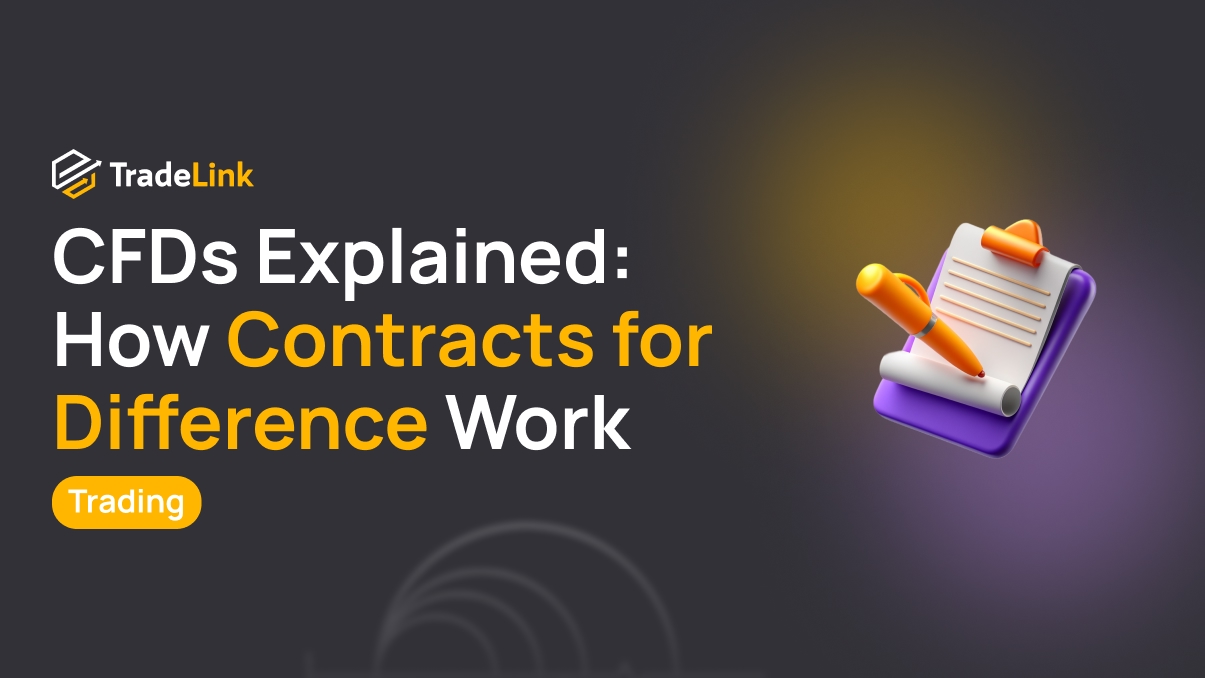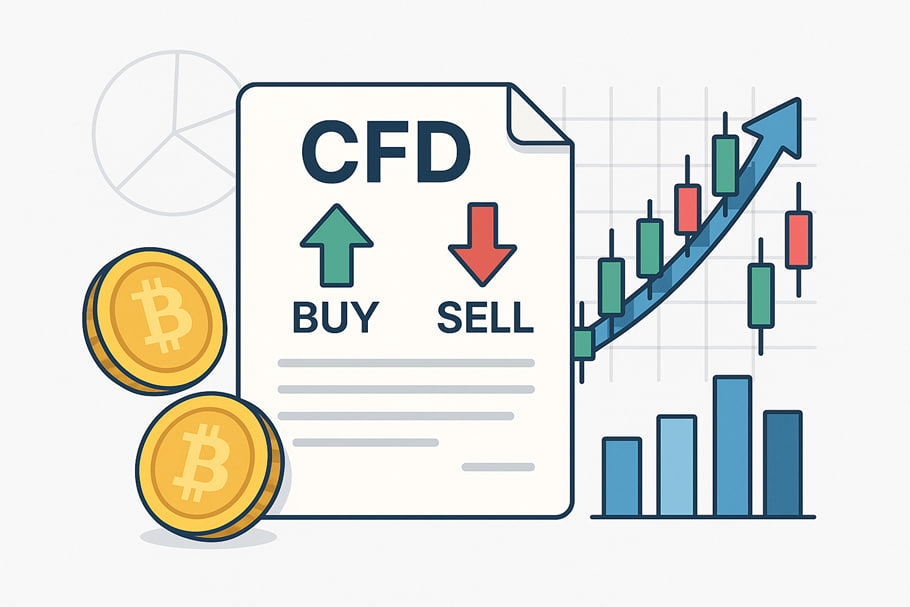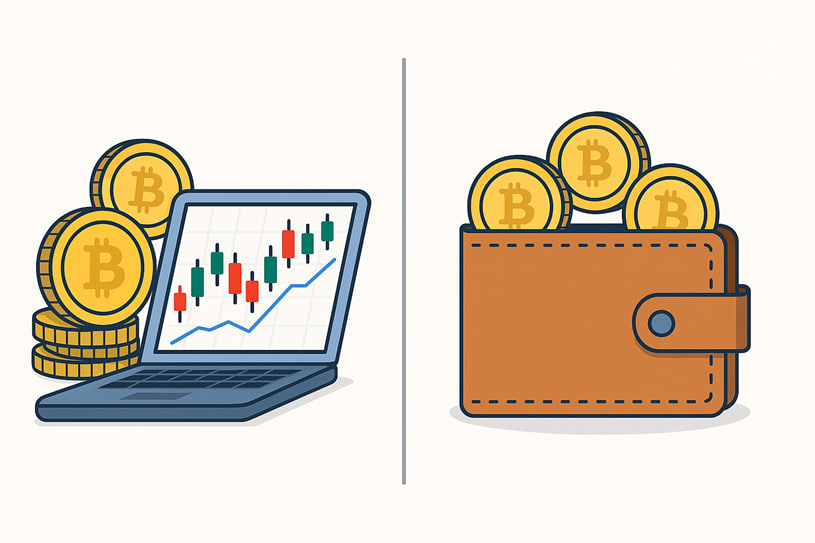CFDs Explained: How Contracts for Difference Work and How to Profit

Contents
- Introduction
- What is a CFD
- How CFDs Work
- Where to Trade Cryptocurrency CFDs
- Differences Between CFDs and Buying Cryptocurrency
- How to Profit from CFDs
- CFDs in Cryptocurrency Trading
- Tips for Beginners
- Conclusion
Introduction
CFDs (Contracts for Difference) allow you to profit from an asset’s price changes without actually purchasing it. They are popular in traditional markets but are also used in crypto trading. CFDs appeal to those who want to use leverage, open short positions, and trade without owning the asset. This article will explore how CFDs work, where they can be traded, how they differ from cryptocurrency buying, and what risks they entail.
What is a CFD

A CFD (Contract for Difference) is an agreement between a trader and a platform, under which the trader gains a profit or incurs a loss depending on the change in the asset’s price between the time of opening and closing the trade. The asset (stock, commodity, currency, or cryptocurrency) is not transferred into ownership.
CFDs allow speculation on upward and downward price movements, utilizing both market growth and decline. This makes the instrument flexible and convenient for short-term trading.
Key features of CFDs:
-
No need to purchase the actual asset
-
Ability to open long and short positions
-
Leverage is available, increasing the trade volume
How CFDs Work
The mechanics of CFD trading are simple: the trader selects an asset, opens a position (buy or sell), and the result of the trade depends on where the price moves.
Example: A trader opens a CFD position to buy Bitcoin at $30,000 with 1:10 leverage. They deposit $3,000. If the price rises to $32,000, they earn the difference ($2,000), multiplied by the position size, minus the commission and spread.
Where to Trade Cryptocurrency CFDs
Cryptocurrency CFDs are not traded on regular crypto exchanges. Instead, they are offered by platforms that operate as brokers, such as eToro, Libertex, XTB, and Capital.com.
These platforms are regulated by financial authorities (FCA, CySEC, etc.), provide access to tools like MetaTrader 4/5, and allow trading through a convenient interface. Through such platforms, one can speculate on the price of Bitcoin, Ethereum, and other assets without buying the coins themselves.
Differences Between CFDs and Buying Cryptocurrency

Feature | CFD | Direct Crypto Purchase |
Asset Ownership | No | Yes |
Short Positions | Yes | No (typically) |
Leverage | Yes | Rarely |
Storage | Not required | Requires a wallet |
Trading Hours | Depends on platform | 24/7 |
Advantages of CFDs:
-
Ability to profit from both market growth and decline
-
Possibility to use leverage
-
No need for a crypto wallet
Disadvantages:
-
High risk of loss with improper leverage usage
-
Commissions for spreads and swaps
-
Not all platforms operate 24/7
How to Profit from CFDs

One must know how to analyze the market and manage risks to profit from CFDs.
-
Asset selection. Popular cryptocurrencies with high liquidity include BTC, ETH, and XRP. These coins are actively traded on most platforms, making them suitable for short-term trading, including CFDs. The high trading volume allows entering and exiting positions without significant slippage.
-
Opening a position. Choose a direction: growth (long) or decline (short).
-
Setting a stop-loss. This limits losses if the market moves against you.
-
Taking profit. Close the position when the price reaches your target.
CFD trading requires a clear plan. It’s best not to trade based on emotion and to define entry and exit levels in advance.
Strategies for CFD Trading
-
Scalping. Short trades within the day, 1–5 minutes. Requires high focus.
-
Day trading. Positions are opened and closed within the same day.
-
Swing trading. Trades are held for several days or weeks. Based on trend-catching.
The choice of strategy depends on the trader’s time, experience, and preferences.
Risk Management
CFDs are high-risk instruments. Without control, you can quickly lose your entire deposit.
What helps:
-
Stop-loss and take-profit orders
-
Trading with small leverage (1:2–1:5)
-
Risking no more than 1–2% of the deposit in one trade
-
Not trading without a strategy
CFDs in Cryptocurrency Trading
Cryptocurrency CFDs are convenient for those who don’t want to store coins or use wallets. They provide access to price movements and are suitable for active speculation. CFDs on Bitcoin and Ethereum are especially popular, but other coins are also available.
Pros:
-
Easy entry: no need to understand blockchain
-
Fast trades
-
No storage issues
Cons:
-
No cryptocurrency ownership
-
Not all platforms provide 24/7 access
-
Risks due to high volatility
Tips for Beginners

-
Start with a demo account. This allows you to familiarise yourself with the platform, test strategies and understand the mechanics of trading without risking money.
-
Use minimal leverage. High leverage might seem attractive, but in reality, it increases risks. Start with 1:2 or 1:3 and evaluate your results.
-
Learn basic analysis. Study how charts, indicators (like RSI and MACD), and candlestick patterns work. Understanding technical analysis helps make better trade entries.
-
Read the news and stay updated. The crypto market is sensitive to news. Blockchain updates, regulator statements, or platform policy changes can influence prices.
-
Keep a trade journal. Record each trade with explanations: why it was opened, where it was closed, and the result. This helps identify mistakes and improve your strategy.
-
Don’t go all-in on one trade. Even the most reliable idea might not work out. Diversification and capital management are the foundation of survival in CFD trading.
Conclusion
CFDs are a convenient way to speculate on cryptocurrency prices without buying them. They allow leverage and the ability to earn in either direction — up or down. But this comes with risk. The key is understanding how the instrument works, choosing reliable platforms, and strictly following capital management rules.
If approached with a clear head, CFDs can be an effective way to profit from cryptocurrencies, especially in short-term trading.